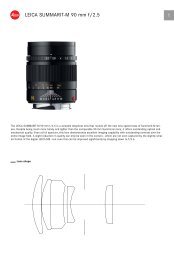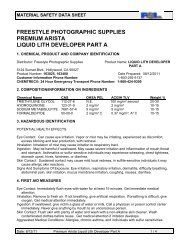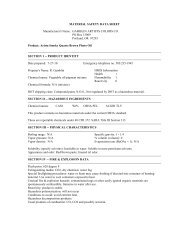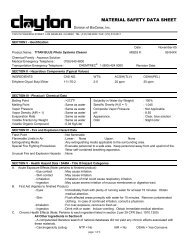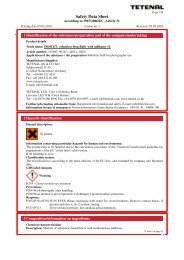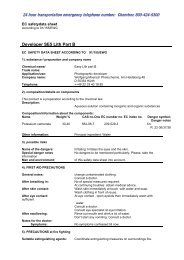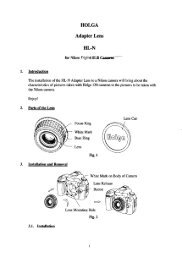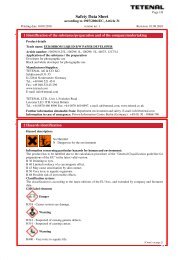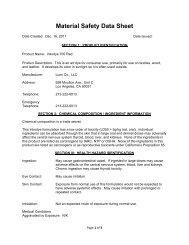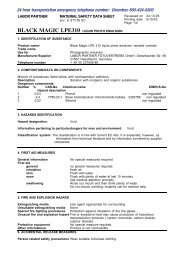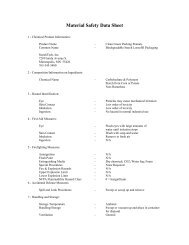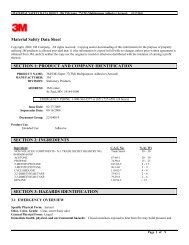PAN F PLUS TECH INFO - the ILFORD PHOTO Website
PAN F PLUS TECH INFO - the ILFORD PHOTO Website
PAN F PLUS TECH INFO - the ILFORD PHOTO Website
You also want an ePaper? Increase the reach of your titles
YUMPU automatically turns print PDFs into web optimized ePapers that Google loves.
<strong>TECH</strong>NICAL <strong>INFO</strong>RMATION<br />
ISO 50/18 o<br />
BLACK AND WHITE PROFESSIONAL FILM<br />
FOR HIGH PRINT QUALITY AND FLEXIBILITY IN USE<br />
<strong>ILFORD</strong> <strong>PAN</strong> F Plus is an extremely fine grain black<br />
and white film. It has outstanding resolution,<br />
sharpness and edge contrast. These characteristics<br />
make it <strong>the</strong> natural choice where fine detail and<br />
lack of grain are more important than film speed.<br />
Mural size enlargements from <strong>PAN</strong> F Plus<br />
negatives show an outstanding range of tone and<br />
detail when <strong>the</strong> film is carefully exposed and<br />
processed.<br />
<strong>PAN</strong> F Plus is compatible with all major processing<br />
systems, including those which give <strong>the</strong> standard<br />
short fixing and washing times.<br />
<strong>PAN</strong> F Plus 35mm film is coated on 0 . 125mm/5-mil<br />
acetate base and is available in 36 exposure<br />
cassettes, or in bulk lengths of 17 and 30 . 5 metres<br />
(55 and 100ft). <strong>PAN</strong> F Plus 35mm film is supplied<br />
in DX coded cassettes, suitable for all 35mm<br />
cameras.<br />
<strong>PAN</strong> F Plus rollfilm is coated on 0 . 110mm/4-mil<br />
clear acetate base with an anti-halation backing<br />
which clears during development. It is available in<br />
120 lengths and is edge numbered 1 to 19.<br />
EXPOSURE RATING<br />
<strong>PAN</strong> F Plus has a speed rating of ISO 50/18 o<br />
(50ASA, 18DIN, EI 50/18) to daylight. The ISO<br />
speed rating was measured using <strong>ILFORD</strong> ID-11<br />
developer at 20 o C/68 o F with intermittent agitation<br />
in a spiral tank.<br />
Best results are obtained at EI 50/18, but good<br />
image quality will also be obtained when <strong>PAN</strong> F<br />
Plus is exposed at EI 25/15.<br />
It should be noted that <strong>the</strong> exposure index (EI)<br />
range recommended for <strong>PAN</strong> F Plus is based on a<br />
practical evaluation of film speed and is not based<br />
on foot speed, as is <strong>the</strong> ISO standard.<br />
Page 1 of 6<br />
SPECTRAL SENSITIVITY<br />
Wedge spectrogram to tungsten light<br />
(2850K)<br />
400 450 500 550 600 650<br />
Wavelength nm<br />
FILTER FACTORS<br />
<strong>PAN</strong> F Plus film may be used with all types of<br />
filters (eg colour, polarising and neutral density<br />
filters) in <strong>the</strong> usual way. Follow <strong>the</strong> instructions<br />
given by <strong>the</strong> filter manufacturer.<br />
1 . 0<br />
0 . 5<br />
The exposure increase in daylight may vary with<br />
<strong>the</strong> angle of <strong>the</strong> sun and <strong>the</strong> time of day. In <strong>the</strong><br />
late afternoon or <strong>the</strong> winter months, when daylight<br />
contains more red light, green and blue filters may<br />
need slightly more exposure than usual.<br />
Cameras with through-<strong>the</strong>-lens metering will usually<br />
adjust <strong>the</strong> exposure automatically when using<br />
filters. With some automatic exposure cameras, <strong>the</strong><br />
correction given for deep red and orange filters<br />
can produce negatives under exposed by as much<br />
as 1 1/ 2 stops.<br />
Sensitivity
<strong>PAN</strong> F Plus<br />
MAKING LONG EXPOSURES<br />
For exposures between 1/ 2 and 1/ 10 000 second, no<br />
adjustments are needed for reciprocity law failure.<br />
When exposures longer than 1/ 2 second are given,<br />
<strong>PAN</strong> F Plus, along with o<strong>the</strong>r films, needs to be given<br />
more exposure than indicated by a meter. Use <strong>the</strong><br />
graph to calculate <strong>the</strong> increased exposure time which<br />
should be given once <strong>the</strong> measured time is known.<br />
5 10 15 20 25 30<br />
Measured exposure time (sec)<br />
Page 2 of<br />
6<br />
175<br />
150<br />
125<br />
100<br />
75<br />
50<br />
25<br />
Adjusted exposure time (sec)<br />
CHOOSING THE BEST <strong>ILFORD</strong> DEVELOPER FOR THE JOB<br />
Manual processing (eg spiral tank, dish/tray, deep tank) and rotary processors<br />
Liquid Powder<br />
Best overall image quality ILFOTEC DD-X ID-11 (stock)<br />
Finest grain ILFOTEC DD-X PERCEPTOL (stock)<br />
Maximum sharpness ILFOTEC DD-X ID-11 (1+3)<br />
One-shot convenience ILFOSOL S<br />
ILFOTEC DD-X<br />
ID-11 (1+1)<br />
MICROPHEN (1+1)<br />
Economy ILFOTEC LC29 (1+29) ID-11 (1+3)<br />
MICROPHEN (1+3)<br />
Rapid processing ILFOTEC HC (1+31) –<br />
Replenishable ILFOTEC HC ID-11<br />
Machine processing<br />
Dip and dunk ILFOTEC DD<br />
ID-11<br />
ILFOTEC HC<br />
Short leader ILFOTEC RT RAPID<br />
ILFOTEC HC<br />
Roller transport ILFOTEC RT RAPID Rapid processing<br />
Best overall image quality (liquid) and long tank life<br />
Best overall image quality (powder) and long tank life<br />
Flexible process time, range of dilutions and economy<br />
Rapid processing, best overall image quality and<br />
long tank life<br />
Range of dilutions, flexibility and economy
<strong>PAN</strong> F Plus<br />
DEVELOPMENT TIMES<br />
The table gives development times for both<br />
manual and machine processing <strong>PAN</strong> F Plus.<br />
These times will produce negatives of average<br />
contrast suitable for printing in all enlargers.<br />
The development times are intended as a guide<br />
and may be altered if a different result is<br />
needed.<br />
Page 3 of<br />
6<br />
For manual processing in spiral tanks and deep<br />
tanks, <strong>the</strong> development times are based on<br />
intermittent agitation. Where continuous<br />
agitation is used for manual processing (as in a<br />
dish/tray or with some types of developing<br />
tank), reduce <strong>the</strong>se times by up to 15%. For use<br />
in rotary processors without a pre-rinse, reduce<br />
<strong>the</strong> spiral tank development times by up to<br />
15%. A pre-rinse is not recommended as it can<br />
lead to uneven processing.<br />
35mm film & Rollfilm<br />
<strong>ILFORD</strong> developer Dilution Meter setting<br />
EI 25/15 EI 50/18 EI 64/19<br />
Spiral tank, deep tank, dip and dunk machines (min/20 o C/68 o F)<br />
ILFOTEC DD-X 1+4 7 8 –<br />
ILFOSOL S 1+9 – 4 –<br />
1+14 – 6 –<br />
ILFOTEC HC 1+31 – 4 –<br />
ILFOTEC LC29 1+19 – 4 –<br />
1+29 – 5 1/ 2 –<br />
ID-11 stock 4 1/ 2 6 1/ 2 –<br />
1+1 6 8 1/ 2 –<br />
1+3 12 1/ 2 15 –<br />
MICROPHEN stock – 4 1/ 2 6<br />
1+1 – 6 9<br />
1+3 – 11 14 1/ 2<br />
PERCEPTOL stock 9 14 –<br />
1+1 10 1/ 2 15 –<br />
1+3 15 17 –<br />
Non-<strong>ILFORD</strong> developer<br />
Acufine Acufine stock – 3 1/ 2 –<br />
Agfa Refinal stock – 5 1/ 2 –<br />
Agfa Rodinal 1+25 – 6 –<br />
1+50 – 11 –<br />
Kodak D-76 stock 4 1/ 2 6 1/ 2 –<br />
1+1 6 8 1/ 2 –<br />
1+3 12 1/ 2 15 –<br />
Kodak HC-110 B – 4 –<br />
Kodak Microdol-X stock 12 15 –<br />
1+3 15 18 –<br />
Kodak T-Max 1+4 – 4 –<br />
Paterson Acutol 1+10 – 10 1/ 2 –<br />
Tetenal Ultrafin 1+10 – 4 –<br />
1+20 – 8 –<br />
Tetenal Ultrafin Plus 1+4 – 5 –<br />
Kodak Xtol stock 5 1/ 2 6 3/ 4 –<br />
Dip and dunk machines (min/24 o C/75 o F)<br />
ILFOTEC DD 1+4 4 1/ 2 5 1/ 2 –<br />
Kodak T-Max RS stock – 3 –<br />
Kodak Xtol stock 4 1/ 2 6 –<br />
ILFOLAB FP40, roller transport and short leader machines (sec)<br />
ILFOTEC RT RAPID 1+1+2/26ºC/79 o F – 40 –<br />
1+1+5/26ºC/79 o F 45 50 –<br />
ILFOTEC HC 1+11/24ºC/75 o F 50 65 –<br />
Kodak Duraflo RT stock/26ºC/79 o F – 50 –
<strong>PAN</strong> F Plus<br />
DEVELOPMENT TIMES<br />
If <strong>PAN</strong> F Plus has been inadvertently exposed at<br />
settings below EI 25/15 or above EI 64/19, <strong>the</strong><br />
following guide will ensure usable negatives are<br />
obtained. Obviously, <strong>the</strong> quality of negatives<br />
processed in this way will not be so high as<br />
conventionally processed ones.<br />
Manual processing (min/20 o C/68 o F) –<br />
accidental exposure only<br />
<strong>ILFORD</strong> Dilution Meter setting<br />
developer EI EI EI<br />
12/12 100/21 200/24<br />
and and<br />
below above<br />
MICROPHEN stock – 8 12<br />
ID-11 stock 4 – –<br />
Note Development times may need adjusting to<br />
suit individual processing systems and working<br />
practices. If an established system is producing<br />
development times until <strong>the</strong> desired contrast level is<br />
obtained. Development times in o<strong>the</strong>r<br />
manufacturers’ developers are included for your<br />
convenience, and are only a general guide. O<strong>the</strong>r<br />
manufacturers can and do change <strong>the</strong>ir product<br />
specifications from time to time, and <strong>the</strong><br />
development times may change as a result.<br />
PROCESSING AT DIFFERENT<br />
TEMPERATURES<br />
<strong>PAN</strong> F Plus film can be processed over a range of<br />
temperatures. Development times at temperatures<br />
o<strong>the</strong>r than 20°C/68 o F may be calculated from <strong>the</strong><br />
chart below.<br />
For example, if 4 minutes at 20°C/68 o F is<br />
recommended, <strong>the</strong> time at 23°C/73 o F will be 3<br />
minutes and <strong>the</strong> time at 16°C/61 o F will be 6<br />
minutes.<br />
New development time (min)<br />
Page 4 of 6<br />
Temperature ( o C)<br />
New development time (min)<br />
CHARACTERISTIC CURVE<br />
1 2 3 4<br />
Relative log exposure<br />
2 . 0<br />
1 . 0<br />
<strong>PAN</strong> F Plus rollfilm developed in <strong>ILFORD</strong> ILFOTEC<br />
HC (1+31) for 4 minutes at 20°C/68 o F with<br />
intermittent agitation. This curve is also<br />
representative of <strong>the</strong> 35mm film format.<br />
Density<br />
Temperature ( o F)
<strong>PAN</strong> F Plus<br />
PROCESSING<br />
<strong>PAN</strong> F Plus can be processed in all types of<br />
processing equipment including spiral tanks, rotary<br />
processors, dishes/trays, deep tanks and<br />
automatic processors. Standard capacity figures<br />
and replenishment rates can be maintained. <strong>PAN</strong> F<br />
Plus is very robust in processing and will tolerate<br />
less than ideal processing conditions. Also, it will<br />
not contaminate <strong>the</strong> processing chemicals.<br />
Safelight recommendations<br />
Handle <strong>PAN</strong> F Plus film in total darkness. For very<br />
brief inspections during processing, use <strong>the</strong> <strong>ILFORD</strong><br />
908 (very dark green) safelight filter, with a 15W<br />
bulb, fitted in a darkroom lamp (such as <strong>the</strong><br />
<strong>ILFORD</strong> DL10 or DL20). Do not allow direct<br />
lighting from <strong>the</strong> safelight to fall on <strong>the</strong> film.<br />
Agitation<br />
Intermittent agitation is recommended for use in<br />
spiral tanks and deep tanks. With spiral tanks,<br />
invert <strong>the</strong> tank four times during <strong>the</strong> first 10<br />
seconds, <strong>the</strong>n invert <strong>the</strong> tank four times again<br />
during <strong>the</strong> first 10 seconds of each fur<strong>the</strong>r minute.<br />
O<strong>the</strong>rwise, follow <strong>the</strong> recommendations given by<br />
<strong>the</strong> processing equipment manufacturer.<br />
Stop, fix, wash and rinse<br />
For best results it is recommended that all process<br />
solutions are kept at <strong>the</strong> same temperature or at<br />
least within 5ºC (9ºF) of <strong>the</strong> developer<br />
temperature.<br />
Stop Bath<br />
After development <strong>the</strong> film can be rinsed in water<br />
but we recommend that an acid stop bath is used<br />
such as <strong>ILFORD</strong> ILFOSTOP (with indicator dye) or<br />
ILFOSTOP PRO (without indicator dye). ILFOSTOP<br />
PRO is recommended for all machine processing<br />
applications. When tanks or dishes (trays) of<br />
process solutions are in use a stop bath<br />
immediately stops development and reduces carry<br />
over of excess developer into <strong>the</strong> fixer bath. This<br />
helps to maintain <strong>the</strong> activity and prolong <strong>the</strong> life<br />
of <strong>the</strong> fixer solution.<br />
<strong>ILFORD</strong> Stop ILFOSTOP ILFOSTOP PRO<br />
Bath<br />
Dilution 1+19 1+19<br />
Temperature 18–24ºC 18–24ºC<br />
range (64–75ºF) (64–75ºF)<br />
Time (seconds)<br />
at 20ºC (68ºF)<br />
Page 5 of 6<br />
10 10<br />
Capacity<br />
films/litre 15x(135–36) 22x(135–36)<br />
(unreplenished)<br />
The process time given is <strong>the</strong> minimum required, if<br />
necessary a longer time may be used and should<br />
not cause any process problems provided it is not<br />
excessive.<br />
Fix<br />
The recommended fixers are <strong>ILFORD</strong> RAPID FIXER<br />
and <strong>ILFORD</strong> HYPAM liquid fixers and <strong>ILFORD</strong><br />
ILFOFIX II powder fixer,all are non-hardening<br />
fixers.<br />
<strong>ILFORD</strong> Fixer <strong>ILFORD</strong> HYPAM & <strong>ILFORD</strong><br />
<strong>ILFORD</strong> RAPID FIXER ILFOFIX II<br />
Dilution 1+4 stock<br />
Temperature 18–24ºC 18–24ºC<br />
range (64–75ºF) (64–75ºF)<br />
Time (mins)<br />
at 20ºC (68ºF)<br />
2–5 4–8<br />
Capacity<br />
films/litre 24x(135–36) 24x(135–36)<br />
(unreplenished)<br />
WASH<br />
When a non-hardening fixer has been used wash<br />
<strong>the</strong> films in running water for 5–10 minutes at a<br />
temperature within 5ºC (9ºF) of <strong>the</strong> process<br />
temperature.<br />
For spiral tank use, when a non-hardening fixer<br />
has been used, <strong>the</strong> following method of washing is<br />
recommended. This method of washing is faster,<br />
uses less water yet still gives negatives suitable for<br />
long term storage.<br />
After fixing, fill <strong>the</strong> spiral tank with water at <strong>the</strong><br />
same temperature, +/– 5ºC (9ºF), as <strong>the</strong><br />
processing solutions and invert it five times. Drain<br />
<strong>the</strong> water away and refill. Invert <strong>the</strong> tank ten times.<br />
Once more drain <strong>the</strong> water away and refill.<br />
Finally, invert <strong>the</strong> tank twenty times and drain <strong>the</strong><br />
water away.<br />
Rinse<br />
For a final rinse use <strong>ILFORD</strong> ILFOTOL wetting<br />
agent added to water, it helps <strong>the</strong> film to dry<br />
rapidly and evenly. Start by using 5ml per litre of<br />
rinse water (1+200), however <strong>the</strong> amount of<br />
ILFOTOL used may need some adjustment<br />
depending on <strong>the</strong> local water quality and drying<br />
method. Too little or too much wetting agent can<br />
lead to uneven drying. Remove excess rinse<br />
solution from <strong>the</strong> film before drying.
<strong>PAN</strong> F Plus<br />
FIX HARDENER<br />
<strong>ILFORD</strong> RAPID FIXER and <strong>ILFORD</strong> ILFOFIX II must<br />
not be used with fix hardeners as <strong>the</strong>y are not<br />
compatible with <strong>the</strong>m. If a fix hardener is required<br />
<strong>the</strong>n only <strong>ILFORD</strong> HYPAM fixer can be used. Add<br />
<strong>ILFORD</strong> HYPAM HARDENER to turn HYPAM into a<br />
hardening fixer.<br />
Generally for most applications modern camera<br />
films are sufficiently hardened at manufacture.<br />
Additional hardening from a fixer hardener is not<br />
usually needed or recommended for processing in<br />
spiral tanks, dishes/trays, deep tanks, rotary<br />
processors, dip and dunk (hanger) machines and<br />
short leader card processors, unless <strong>the</strong> processing<br />
temperature is above 30ºC (86ºF), or poor drying<br />
performance is being experienced. To minimise <strong>the</strong><br />
risk of physical damage a fixer hardener may be<br />
needed when using a roller transport film<br />
processor.<br />
Using a fix hardener will require <strong>the</strong> recommended<br />
fix and wash times to be extended. Depending on<br />
<strong>the</strong> film and processing conditions <strong>the</strong> hardened<br />
fix time will be between 4 and 10 minutes and <strong>the</strong><br />
subsequent wash time 10–20 minutes in running<br />
water.<br />
The amount of HYPAM HARDENER that can be<br />
added to <strong>the</strong> fixer is dependant on <strong>the</strong> film and<br />
process conditions used. In some processors <strong>the</strong><br />
full amount of hardener cannot be used as <strong>the</strong> fix<br />
and wash times cannot be extended adequately. In<br />
<strong>the</strong>se circumstances we recommend starting with<br />
<strong>the</strong> minimum amount of hardener to have some<br />
effect. This is around 3–6 mls of hardener per litre<br />
of working strength HYPAM used. This increases<br />
<strong>the</strong> film hardness slightly but has a negligible effect<br />
on <strong>the</strong> fix and wash efficiency. When fix and wash<br />
times are restricted <strong>the</strong> maximum amount of<br />
HYPAM HARDENER recommended is 10–20ml of<br />
hardener per litre of working strength HYPAM<br />
used. This higher amount gives a definite increase<br />
to <strong>the</strong> hardness of <strong>the</strong> films processed and while<br />
fixing and washing efficiency are reduced <strong>the</strong> films<br />
will be adequately fixed and washed for most<br />
purposes.<br />
When fix and wash times can be extended <strong>the</strong><br />
maximum amount of HYPAM HARDENER needed<br />
to achieve fully hardened films is 1 part to 40<br />
parts working strength HYPAM i.e. 24 ml per litre.<br />
Page 6 of 6<br />
Drying<br />
To avoid drying marks, use a clean squeegee or<br />
chamois cloth to wipe <strong>PAN</strong> F Plus film before<br />
hanging it to dry. Dry <strong>PAN</strong> F Plus at 30–40°C/86-<br />
104 o F in a drying cabinet or at room temperature<br />
in a clean dust-free area.<br />
STORAGE<br />
Store <strong>PAN</strong> F Plus in a cool (10–20°C/50-68 o F),<br />
dry place in its original packaging.<br />
Exposed film<br />
Once exposed, process <strong>PAN</strong> F Plus as soon as<br />
practical. Images on exposed but unprocessed film<br />
will not degrade for up to several months when<br />
stored as recommended.<br />
Negatives<br />
Store processed negatives in a cool (10–20°C/50-<br />
68 o F), dry place, in <strong>the</strong> dark. Suitable storage<br />
sleeves include those made of cellulose triacetate,<br />
Mylar, paper (pH6 . 5–7 . 5) or inert polyester.<br />
A wide range of fact sheets is available which describe and<br />
give guidance on using <strong>ILFORD</strong> products. Some products in<br />
this fact sheet might not be available in your country.<br />
HARMAN technology Limited, Ilford Way,<br />
Mobberley, Knutsford, Cheshire WA16 7JL, England<br />
www.ilfordphoto.com<br />
June 2010




